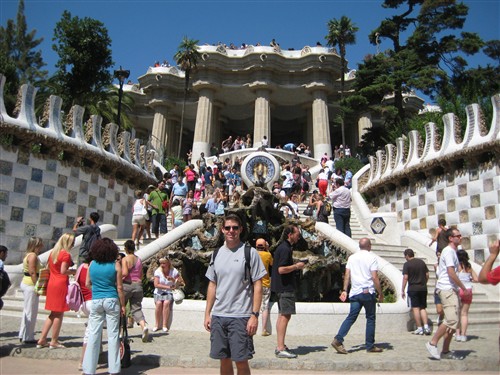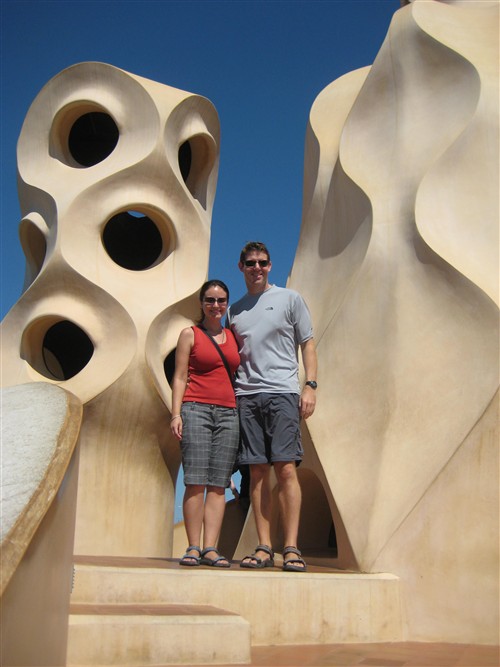Posted under Spain
 Never again will we underestimate the contributions of the Spanish to the overall beauty of the world…and I’m not just talking about the dark hair, Mediterranean skin and heaving cleavage. We have waded into the Barcelona art scene, a playground of Picasso and Modernista architect, Antoni Gaudi. With six nights to play, we felt sure that we could visit Barcelona’s most impressive sights with plenty of time leftover for sangria and the beach. We were mostly right.
Never again will we underestimate the contributions of the Spanish to the overall beauty of the world…and I’m not just talking about the dark hair, Mediterranean skin and heaving cleavage. We have waded into the Barcelona art scene, a playground of Picasso and Modernista architect, Antoni Gaudi. With six nights to play, we felt sure that we could visit Barcelona’s most impressive sights with plenty of time leftover for sangria and the beach. We were mostly right.
We arrived in the late afternoon and went directly to La Rambla, a beautiful tree-lined pedestrian walkway lined with cafés and restaurants. Barcelona’s most famous street was thronged with locals and tourists alike, strolling the lane and absorbing the vibrant activity. Interspersed with the fresh flower stalls, souvenir stands, small pet shops and street artists, costumed street performers drew the biggest crowds. Nowhere have we seen more elaborate costumes outside a theatre than we have on La Rambla. The street was full of life and we would stroll it nearly every day during our stay.
The next day, we began by walking through the tangled medieval stone alleys of Barri Gotic, Barcelona’s Gothic quarter, walking through its magnificent Gothic cathedral and then, the highlight of our day – the Picasso Museum. Barcelona’s most visited museum is housed in five medieval stone mansions. The corridors are dim and cavernous while the galleries are bright and airy to showcase the work. The museum exhibits Picasso’s earliest works, including oil paintings on postcard-size pieces of wood, sketches, sculptures, many works from his famous Blue Period and a tireless study of Las Meninas by Diego Velazquez. The museum was fascinating because it displayed many works from Picasso’s earlier, more traditional style of painting and followed his transition to the Cubism for which he is most famous.
The artist who has left by far the most stunning and visible fingerprint on Barcelona is Antoni Gaudi (1852-1926). He was a pioneering architect of the Modernista period in Spain, during which innovative artists showcased bold, modern designs in architecture as symbols of the rising affluence of the Spanish bourgeois.
 We devoted an entire day to admiring Gaudi’s brilliant work, beginning with a visit to Park Guell. The project began in 1900, on a piece of prime real estate overlooking the sea, as a housing development for the wealthy but ended fourteen years later as a commercial failure. The city later purchased the incomplete development and turned it into a public park. From the metro stop, a series of escalators carried excitable tourists up the side of a steep hill. Once inside the park, landscaped gravel walking trails wound around the hillside overlooking the Mediterranean. The trails eventually led to the remnants of Gaudi’s creations for the original housing development project: two “gingerbread” gatehouses, a colorful, curvy plaza and 3km of roads, walks and steps. The park was a beautiful place for a picnic and many people had copped a squat in the pillared pavilion at the entry while musicians played for tips. The plaza was a large open area surrounded by a squiggly mosaic bench and it was there that I really began to visualize the potential of the original project. It would have been like living in a fun house with pretty touches everywhere to make people smile. That was Gaudi’s way.
We devoted an entire day to admiring Gaudi’s brilliant work, beginning with a visit to Park Guell. The project began in 1900, on a piece of prime real estate overlooking the sea, as a housing development for the wealthy but ended fourteen years later as a commercial failure. The city later purchased the incomplete development and turned it into a public park. From the metro stop, a series of escalators carried excitable tourists up the side of a steep hill. Once inside the park, landscaped gravel walking trails wound around the hillside overlooking the Mediterranean. The trails eventually led to the remnants of Gaudi’s creations for the original housing development project: two “gingerbread” gatehouses, a colorful, curvy plaza and 3km of roads, walks and steps. The park was a beautiful place for a picnic and many people had copped a squat in the pillared pavilion at the entry while musicians played for tips. The plaza was a large open area surrounded by a squiggly mosaic bench and it was there that I really began to visualize the potential of the original project. It would have been like living in a fun house with pretty touches everywhere to make people smile. That was Gaudi’s way.
 After the park, we moved on to another one of Gaudi’s creations – La Pedrera – an apartment building commissioned by a well-to-do couple. “La Pedrera”, meaning stone quarry, was a nickname given to the building because it looks like it is carved out of stone. The completed building consists of two blocks of apartments, each with its own interior courtyard, and with one continuous façade that curves around a corner lot. An apartment on the fourth floor was decorated as it would have been in the early 1900’s, when it was inhabited by the Barcelona bourgeois. The floor plan encircled a large interior courtyard, filling the apartment with light. From the swirling ceilings and parquet floors to the moulding, door knobs and other ornamental embellishments, every detail of the interior has Gaudi’s personal touch.
After the park, we moved on to another one of Gaudi’s creations – La Pedrera – an apartment building commissioned by a well-to-do couple. “La Pedrera”, meaning stone quarry, was a nickname given to the building because it looks like it is carved out of stone. The completed building consists of two blocks of apartments, each with its own interior courtyard, and with one continuous façade that curves around a corner lot. An apartment on the fourth floor was decorated as it would have been in the early 1900’s, when it was inhabited by the Barcelona bourgeois. The floor plan encircled a large interior courtyard, filling the apartment with light. From the swirling ceilings and parquet floors to the moulding, door knobs and other ornamental embellishments, every detail of the interior has Gaudi’s personal touch.
Just a few blocks down the road, Casa Batllo was my favorite Gaudi masterpiece. It was a remodel of an existing house, commissioned by the Batllo family, and created by Gaudi with an “under the sea” theme. The façade is a vision of waves in blue, mauve and green tile, leading up to an uneven blue-tiled roof. Inside, everything waves and swirls – hardly a single straight line can be found – and the rooms are full of color and light. The rooftop terrace, which overlooks pretty Passeig de Gracia, is a surprising delight with mosaic chimney sculptures, multiple levels, and a small cavernous room with a water feature that makes an echoing sound of rain. Every aspect of Casa Batllo is beautiful and functional and brilliant. It is a dream house!
 Exhausted but still trudging along, we made our way to Gaudi’s most famous creation and Barcelona’s most famous work-in-progress: La Sagrada Familia. Begun in 1882, the church was the project to which Gaudi dedicated the latter part of his life and was left incomplete when Gaudi died in 1926. It is an awe-inspiring synergy of a traditional Gothic design and Gaudi’s shocking Modernista flair. Stunning sculptured façades seem to jump off the church and the narrow pointed towers are breathtaking to behold. La Sagrada Familia looks more like a fairy tale castle than a church. Work continues slowly, according to Gaudi’s original designs. The completed structure will be a glorious monument to an artist who left an unforgettable mark on Barcelona. The photos simply do not do it justice. It is a church unlike any the world has ever seen.
Exhausted but still trudging along, we made our way to Gaudi’s most famous creation and Barcelona’s most famous work-in-progress: La Sagrada Familia. Begun in 1882, the church was the project to which Gaudi dedicated the latter part of his life and was left incomplete when Gaudi died in 1926. It is an awe-inspiring synergy of a traditional Gothic design and Gaudi’s shocking Modernista flair. Stunning sculptured façades seem to jump off the church and the narrow pointed towers are breathtaking to behold. La Sagrada Familia looks more like a fairy tale castle than a church. Work continues slowly, according to Gaudi’s original designs. The completed structure will be a glorious monument to an artist who left an unforgettable mark on Barcelona. The photos simply do not do it justice. It is a church unlike any the world has ever seen.
Antoni Gaudi has been the highlight of our visit to Barcelona. His masterworks light up the city. They make people point and smile. He was unconventional and inventive. His sense of humor and zest for life are manifest in the many works he has left for the world to enjoy.
Comments Off on So Gaudi
